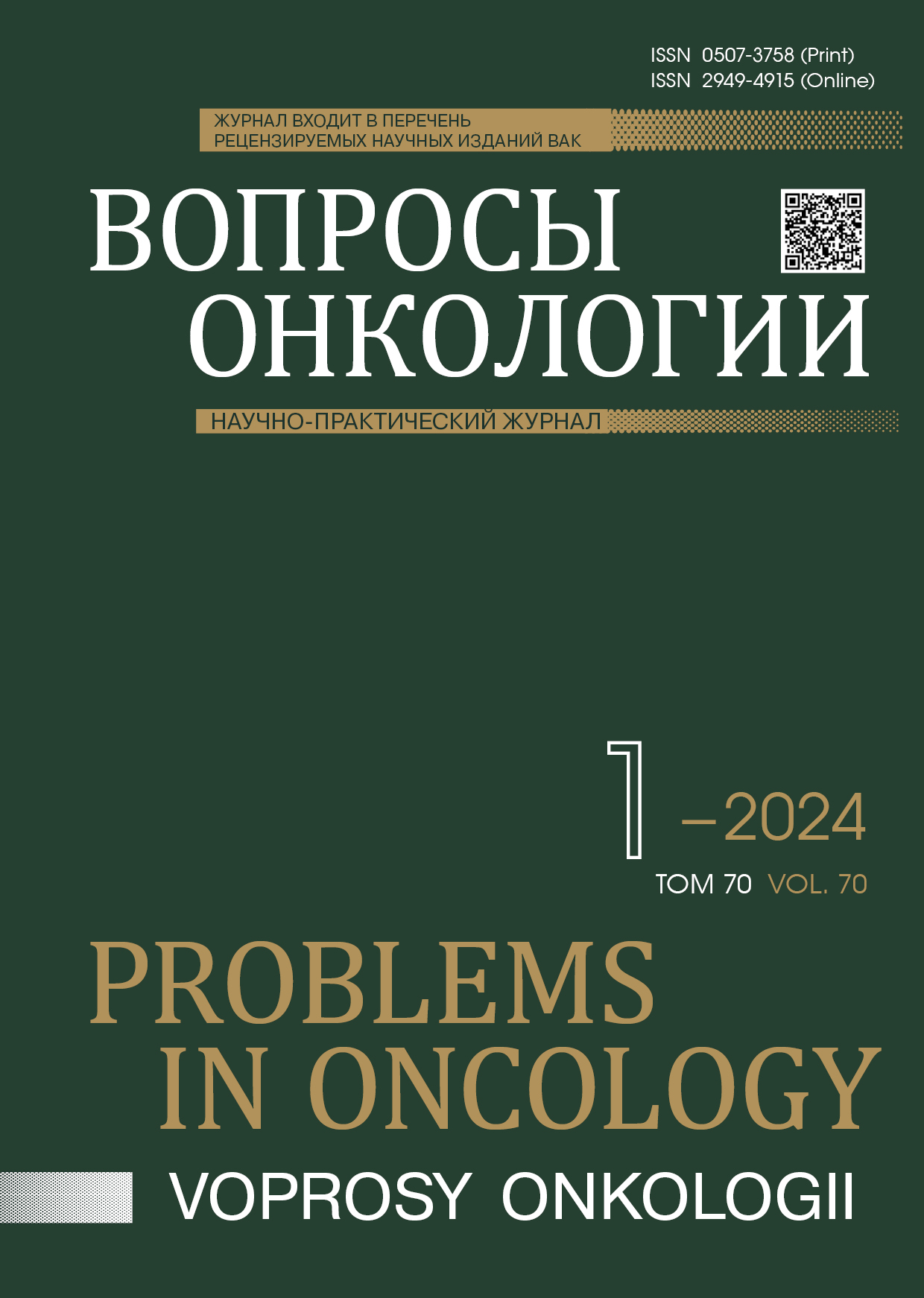Abstract
Introduction. Atypical teratoid rhabdoid tumors (ATRO) are extremely rare aggressive tumors of childhood with predominant occurrence in patients under 3 years of age and primary localization within the central nervous system (CNS). Despite intensive multimodal treatment approaches, the prognosis in this cohort of patients remains unsatisfactory.
Case description. We present a case of an aggressive primary metastatic ATRT in combination with low-grade glioma in infant with rhabdoid tumor predisposition syndrome I (hereditary mutation in the SMARCB1 gene). The use of multimodal antitumor therapy according to the recommendations of the Medical University of Vienna (MUV ATRT) and metronomic chemotherapy was accompanied by a long-term effect. However, with the subsequent rapid progression of the disease, all treatment attempts were unsuccessful, and the patient died 44 months after diagnosis.
References
Woehrer A, Slavc I, Waldhoer T, et al. Incidence of atypical teratoid/rhabdoid tumors in children: a population-based study by the Austrian Brain Tumor Registry, 1996-2006. Cancer. 2010; 116(24): 5725-32.-DOI: https://doi.org/10.1002/cncr.25540.
Tekautz T.M., Fuller C.E., Blaney S., et al. Atypical teratoid/rhabdoid tumors (ATRT): improved survival in children 3 years of age and older with radiation therapy and high-dose alkylator-based chemotherapy. J Clin Oncol. 2005; 23(7): 1491-9.-DOI: https://doi.org/10.1200/jco.2005.05.187.
Rechberger J.S., Nesvick C.L., Daniels D.J. Atypical teratoid rhabdoid tumor (ATRT): disease mechanisms and potential drug targets. Expert Opinion on Therapeutic Targets. 2022; 26(3): 187-192.-DOI: https://doi.org/10.1080/14728222.2022.2040017.
Bourdeaut F., Lequin D., Brugières L., et al. Frequent hSNF5/INI1 germline mutations in patients with rhabdoid tumor. Clin Cancer Res. 2011; 17(1): 31-38.-DOI: https://doi.org/10.1158/1078-0432.CCR-10-1795.
Del Baldo G., Carta R., Alessi I., et al. Rhabdoid tumor predisposition syndrome: from clinical suspicion to general management. Front Oncol. 2021; 11: 586288.-DOI: https://doi.org/10.3389/fonc.2021.586288.
Nemes K., Johann P.D., Steinbügl M., et al. Infants and newborns with atypical teratoid rhabdoid tumors (ATRT) and extracranial malignant rhabdoid tumors (eMRT) in the EU-RHAB registry: a unique and challenging population. Cancers. 2022; 14: 2185.-DOI: https://doi.org/10.3390/cancers14092185.
Reddy A.T., Strother D.R., Judkins A.R., et al. Efficacy of high-dose chemotherapy and three-dimensional conventional radiation for atypical teratoid/rhabdoid tumor: a report from the children’s oncology group trial ACNS0333. J Clin Oncol. 2020; 38: 1175-85.-DOI: https://doi.org/10.1200/JCO19.01776.
Park M., Han J.W., Hahn S.M., et al. Atypical teratoid/rhabdoid tumor of the central nervous system in children under the age of 3 years. Cancer Res Treat. 2021; 53(2): 378-388.-DOI: https://doi.org/10.4143/crt.2020.756.
Hoffman L.M., Richardson E.A., Ho B., et al. Advancing biology-based therapeutic approaches for atypical teratoid rhabdoid tumors. Neuro Oncol. 2020; 22(7): 944-954.-DOI: https://doi.org/10.1093/neuonc/noaa046.
Slavc I., Chocholous M., Leiss U., et al. Atypical teratoid rhabdoid tumor: improved long-term survival with an intensive multimodal therapy and delayed radiotherapy. The Medical University of Vienna Experience 1992–2012. Cancer Med. 2014; 3(1): 91-100.-DOI: https://doi.org/10.1002/cam4.161.
Fruhwald M.C., Hasselblatt M., Nemes K., et al. Age and DNA methylation subgroup as potential independent risk factors for treatment stratification in children with atypical teratoid/rhabdoid tumors. Neuro. Oncol. 2020; 22: 1006-1017.-DOI: https://doi.org/10.1093/neuonc/noz244.
Alva E., Rubens J., Chi S., et al. Recent progress and novel approaches to treating atypical teratoid rhabdoid tumor. Neoplasia. 2023; 37: 100880.-DOI: https://doi.org/10.1016/j.neo.2023.100880.
Zhang C., Li H. Molecular targeted therapies for pediatric atypical teratoid/rhabdoid tumors. Pediatr Investig. 2022; 6(2): 111-122.-DOI: https://doi.org/10.1002/ped4.12325.
Berland M., Padovani L., Rome A., et al. Sustained complete response to metronomic chemotherapy in a child with refractory atypical teratoid rhabdoid tumor: a case report. Front Pharmacol. 2017; 8: 1-4.-DOI: https://doi.org/10.3389/fphar.2017.00792.
Kerbel R.S., Kamen B.A. The anti-angiogenic basis of metronomic chemotherapy. Nat Rev Cancer. 2004; 4: 423-436.-DOI: https://doi.org/10.1038/nrc1369.
Bowers D.C., Aquino V.M., Leavey P.J., et al. Phase I study of oral cyclophosphamide and oral topotecan for children with recurrent or refractory solid tumors. Pediatr Blood Cancer. 2004; 42: 93-98.-DOI: https://doi.org/10.1002/pbc.10456.
Sterba J., Pavelka Z., Andre N., et al. Second complete remission of relapsed medulloblastoma induced by metronomic chemotherapy. Pediatr Blood Cancer. 2010; 54(4): 616-7.-DOI: https://doi.org/10.1002/pbc.22382.
Stoelting S., Trefzer T., Kisro J., et al. Low-dose oral metronomic chemotherapy prevents mobilization of endothelial progenitor cells into the blood of cancer patients. In Vivo. 2008; 22(6): 831-6.
Peyrl A., Chocholous M., Kieran M.W., et al. Antiangiogenic metronomic therapy for children with recurrent embryonal brain tumors. Pediatr Blood Cancer. 2012; 59(3): 511-7.-DOI: https://doi.org/10.1002/pbc.24006.
Winnicki C., Leblond P., Bourdeaut F., et al. Retrospective national “Real Life” experience of the SFCE with the Metronomic MEMMAT and MEMMAT-like Protocol. J Clin Med. 2023; 12(4): 1415.-DOI: https://doi.org/10.3390/jcm12041415.
Fruhwald M.C., Nemes K., Boztug H., et al. Current recommendations for clinical surveillance and genetic testing in rhabdoid tumor predisposition: a report from SIOPE Host Genome Working Group. Familial Сancer. 2021; 20: 305-316.-DOI: https://doi.org/10.1007/s10689-021-00229-1.

This work is licensed under a Creative Commons Attribution-NonCommercial-NoDerivatives 4.0 International License.
© АННМО «Вопросы онкологии», Copyright (c) 2024

